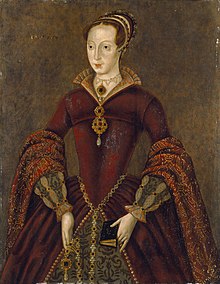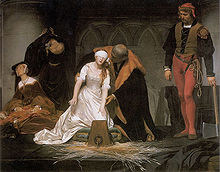Lady Jane Grey

Lady Jane Grey, born on October 12, 1537, also known as "The Nine Days Queen," was an English noblewoman who briefly served as queen of England from 10 July to 19 July 1553. Her reign was unsuccessful, and she was subsequently executed by decapitation the following year on February 12, 1554, at the age of 17, charged with high treason.
Jane was born in London, or at her family home of Bradgate Park, Leicestershire, England.[2] She was great-granddaughter of Henry VII by his younger daughter Mary, and a first-cousin-once-removed of Edward VI.
In May 1553, Jane married Lord Guildford Dudley, a younger son of Edward's chief minister, John Dudley, Duke of Northumberland. When the 15-year-old King lay dying in June 1553, he nominated Jane as successor to the Crown in his will, thus subverting the claims of his half-sisters Mary and Elizabeth.
During her short reign, Jane lived in the Tower of London. She became a prisoner there, as the Privy Council decided to change sides and proclaim Mary as queen, on 19 July 1553. Wyatt's rebellion in January and February 1554 against Queen Mary's plans of a Spanish match was the direct cause of Jane's and her husband's execution.
Early life[change | change source]
Jane's parents were very strict even by the standards of the day. If she made mistakes in her studies or had any other normal troubles, her mother would slap her or beat her. She found she loved her nurse, but otherwise lived a sad childhood.
She told a visiting scholar Roger Ascham:
"For when I am in the presence of either Father or Mother, whether I speak, keep silence, sit, stand or go, eat, drink, be merry or sad, be sewing, playing, dancing, or doing anything else, I must do it as it were in such weight, measure and number, even so perfectly as God made the world; or else I am so sharply taunted, so cruelly threatened, yes presently sometimes with pinches, nips and bobs and other ways ... that I think myself in hell".[3]
When Jane was nine, she was sent to the royal court to learn etiquette and manners with Henry VIII's sixth wife and eventual widow, Catherine Parr. Jane liked Catherine a great deal and found love with her, which she had not got from her parents. It was clear that Catherine was very fond of Jane in return.
Jane also found friendship with her cousin and future king Edward VI. They often studied together.
Jane was well educated as a child and learned to read in Latin, Greek, French and Italian, as well as English. Later in her life, she also learned Hebrew.
Parents' political ambitions[change | change source]
Jane's parents, especially her mother, wanted to gain more political influence. For that reason, they wanted to marry her to someone important. Jane had two sisters, Catherine, born in 1540, and Mary, born in 1545. After her sisters were born, her parents tried to marry Jane to her cousin Edward VI. They went to Catherine Parr's new husband, Thomas Seymour, to try to prepare this royal marriage. It is likely that King Edward loved Jane. However, he decided to arrange a marriage with a foreign princess instead.
In 1548, Jane was sent to Chelsea to be with Catherine Parr and Thomas Seymour. Catherine Parr became pregnant that same year and the family moved to Sudeley Castle in June, taking Jane with them. Tragedy struck when Catherine Parr died while having the baby in August of that year and Jane served as chief mourner in her funeral.
Jane was dealt another blow in 1549 when Thomas Seymour was arrested on charges of treason. She was sent back to her angered parents. They knew that their hopes of her marriage to the king were ruined; they punished her cruelly for this, even though it was not her fault.
Youth[change | change source]
In 1551 Jane's mother's two half-brothers died of the "sweating sickness", a contagious disease that caused a series of epidemics, 1485 to 1551. Since Frances's father was dead, she became Duchess of Suffolk. Jane's father became Duke of Suffolk. In the same year John Dudley was made the Duke of Northumberland and the chief councillor to Edward VI.
John Dudley's plot[change | change source]
In April 1552 Edward became sick with the measles and caught tuberculosis as well. By next year, Edward was so ill that he was weak and spitting up blood or something that was greenish-yellow. It was clear that he was going to die soon.
Dudley knew that if either of Edward's half-sisters, Mary or Elizabeth, became queen, he would not be powerful anymore.[4] Dudley plotted with Jane's equally ambitious parents and planned that Jane became his ward, and also that she marry his son, Guildford Dudley. Jane's mother decided to give up her claim to be queen for Jane. This did not mean that Frances was any less greedy, however. This meant that Jane would become Frances and Dudley's puppet and do what they wanted. Now Jane would be the next in line to the throne if the rights of the princesses Mary and Elizabeth were ignored.
Marriage[change | change source]
When Jane's mother and father told her that Jane was going to get married, Jane refused. She said that Guildford was ugly, stupid, and rude. She also hated John Dudley. When Jane refused, Frances and Henry swore at Jane and slapped her. This did not work, so Frances gave Jane a brutal whipping. Finally, Jane agreed. The wedding between Jane and Guildford happened on 25 May 1553. This became a triple marriage because Jane's sister, Katherine, was married at this time to Lord Herbert, and Guildford's sister, Katherine, was also married to Lord Hastings.
Accession[change | change source]
On 6 July 1553, King Edward VI died. Dudley's plan to make Jane queen was starting to take place. Edward's death was kept secret for a few days until Jane could be proclaimed queen.
Jane was told by her parents and John Dudley that she was queen. She became sick with fright and fainted. She did not want to take the crown. "The crown is not my right. It pleaseth me not. The Lady Mary is the rightful heir," Jane said. Her parents swore at her and John Dudley told her that she "doth wrong to herself and her house". Under pressure, Jane finally relented. Lady Jane said she never forgave herself for doing this.
Meanwhile, news was spreading that Jane had been proclaimed the new queen. Although the people liked Jane, they loved Mary and Elizabeth more. They also did not like John Dudley. In East Anglia, Mary was gaining support and planning to march into London. Dudley tried to enforce a counter-attack but to no avail. On 19 July Mary became queen. Jane was queen for nine days.
Imprisonment[change | change source]
Jane returned all the crown jewels and clothes. She was then brought into the Tower of London. There, she was kept in a cell for the next few months. However, she was allowed to walk in the garden. She wrote many letters and read many books while at the Tower of London. She wrote a letter to Queen Mary saying that she never wanted the crown. Queen Mary believed Jane and refused to execute her cousin. Many people pressured Mary, but she was stubborn. She still ordered that a trial be held for traditional purposes. Jane was found guilty but the Queen pardoned her.
However, the next year, 1554, a group of rebels under Thomas Wyatt, including Jane's father Henry Grey, led a rebellion against Queen Mary because she was planning to marry prince Phillip II of Spain. It was quickly put down. Although Jane had nothing to do with it and Mary did not want to kill her cousin, her advisors told her that Phillip would only come if Jane was killed. So, with a heavy heart (sadly), Queen Mary signed the death warrant. Jane was going to be beheaded.
Effects[change | change source]
When Jane was told that her head was going to be cut off, she was very scared. Nonetheless, she was happy that her "sad and woeful days" of life were finally coming to an end.
Meanwhile, Mary still did not want to kill her cousin. So, she sent a Catholic priest Dr. Feckenham to try to convert Jane to Catholicism. That way, Jane would not be a threat. Jane was a firm Protestant, and refused to become a Catholic. Jane's execution was postponed from 9 February to 12 February, to try and make her a Catholic. The night before the execution, Jane wrote many letters to her family and prepared her neck for the block. The next morning, her hair was tied back, and she watched Guildford go very unwillingly to the block. Then it was her turn.
Execution[change | change source]

On 12 February 1554, at the Tower of London, Jane was sent to the scaffold. She calmly climbed the scaffold and said a speech. She said the Psalm 51, a prayer for divine mercy, in "the most devout manner". She then knelt by the block and tied a piece of cloth around her eyes.
When the executioner told her to put her head on the block, she reached out but could not find the block since she was very scared. She cried for help until someone grabbed her hands and helped her find the block. Jane then put her neck above the block and slowly lowered it onto the block, pressed her neck against the wood and fit her chin in the hold. Then she brought her arms around her. Before she was executed, she cried out "Lord, into thy hands, I commend my spirit!"
Some say her last words were the name of her much loved husband, Lord Guildford.
Beheading[change | change source]
The crowd watched as the executioner raised the axe high in the air. Jane was shivering badly but her neck stayed perfectly still. Then, the executioner quickly swung the axe down perfectly at the middle of Jane's neck, which was severed in a single stroke. Jane's severed head fell to the straw in front of the block while huge amounts of blood splattered across the scaffold. The executioner then grabbed Jane's head by her red hair and lifted it up to show the crowd. He shouted "So perish all the Queen's enemies! Behold the head of a traitor!"
But some sources suggest the fact that it took three shots to remove Lady Jane's head.
Burial[change | change source]
After the crowd left, the blood was removed, and Jane's body was brought to the church St. Peter ad Vincula.[4] Since the church had just become Catholic and Jane was a Protestant, they had to get permission from Queen Mary to bury her. It was four hours until her maids were allowed to prepare her body for burial. Jane's body was buried between former Queens Anne Boleyn and Catherine Howard. It is unknown what happened to her severed head.
References[change | change source]
- ↑ Higgins, Charlotte (2006-01-16). "Is this the true face of Lady Jane?". The Guardian. Retrieved 2008-05-11.
- ↑ her date and place of birth is disputed
- ↑ Waller, Maureen 2006. Sovereign ladies: sex, sacrifice and power: the six reigning queens of England. New York: St. Martin's Press. ISBN 0-312-33801-5.
- ↑ 4.0 4.1 Cite error: The named reference
hrp.orgwas used but no text was provided for refs named (see the help page).
Further reading[change | change source]
 Media related to Lady Jane Grey at Wikimedia Commons
Media related to Lady Jane Grey at Wikimedia Commons- Ives, Eric (2009). Lady Jane Grey: A Tudor Mystery. Malden MA; Oxford UK: Wiley-Blackwell. ISBN 978-1-4051-9413-6
- Loades, David (1996), John Dudley Duke of Northumberland. 1504–1553, Oxford: Clarendon Press, ISBN 0-19-820193-1
- Cook, Faith (2005). The Nine Day Queen of England. Evangelical Press. ISBN 978-0-85234-613-6
